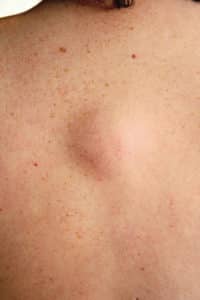Treatment Solutions for Cysts, Moles, and Lipomas in Short Hills, NJ
Skincare solutions for the treatment of cysts, moles, and lipomas are best prescribed by consulting a board certified dermatologist. These growths, which can appear on the body at any time during a person’s life, can often cause anxiety due to the self-conscious reaction of patients who do not like the way they change their appearance. In more serious cases they can interfere with movement, or they can even indicate that a patient is potentially suffering from a more serious medical problem. By consulting with a board certified dermatologist such as Dr. Lin, Dr. Farley-Loftus and Dr. Vuong in Short Hills, New Jersey patients from northern New Jersey in towns such as Livingston, Cranford, Clark, Springfield and all of Union County have been treated with the most advanced dermatological tools and medicines available.
Board Certified Dermatologists and Skin Growth Treatment
Because a board certified dermatologist is an expert in skin structure and function, they are the best expert medical professionals to determine treatment for your lipoma, cyst, or mole.
What Are Moles?

Moles can occur anywhere on the body as a skin growth, but most commonly they are found in areas that have received exposure to the sun. They are (mainly) benign growths that are caused by the proliferation of melanocytes (the pigment cells in our skin). Moles can be a variety of colors and shapes. They can be brown, pink, or flesh colored. They are often mistaken with freckles, skin tags, sunspots, age spots and seborrheic keratoses.
How Common Are Moles?
It is perfectly normal to have several dozen moles by the time a person is in their twenties. Most moles will form during adolescence and early adulthood. As time passes moles can change in shape and color and size.
Are Moles Dangerous?
Most moles are actually not dangerous and some can even disappear over time. However, it is important to keep an eye on any moles to determine which are exhibiting indications of skin cancer (i.e. basal skin cancer, melanoma, squamous cell skin cancer) and those that are benign. It is highly recommended that any individual that suspects a mole to be anything other than a benign growth (whether due to strong family history of skin cancer or other cancers, or simply because of any changes in the shape, color, or size of a mole) have their skin checked on a regular basis by a board certified dermatologist.
Dangerous Mole Treatment
If you are a patient at risk, your dermatologist may choose to perform a full skin exam, also referred to as a skin cancer screening. If he or she feels that a lesion may be cancerous they may perform a biopsy. Mole removals may also be performed simply for cosmetic reasons and this can be done surgically or through laser treatment for moles.
What Are Cysts?
A cyst is a small growth that will present itself as an area of skin that can be inflamed, infected, or even deformed (if the cyst grows large enough). Called “sebaceous” cysts, they are typically small, and can also be referred to as epidermal inclusion cysts because they are closed sacs that can contain fluid or solid material and that sit below the skin’s surface. Cysts are benign, but they can cause the before stated problems of inflammation and infection, or disfigurement.
Typical Cyst Treatment
In order to remove a cyst a board certified dermatologist may utilize injections or surgical removal techniques depending on the stage of the cyst, its size and it’s location.
What Are Lipomas?
 Often soft, mobile, painless bumps, Lipomas are a benign (non-cancerous) growth that is made from fat tissue. They can be felt underneath the skin, and typically present as small growths, but can also grow to be several centimeters in size.
Often soft, mobile, painless bumps, Lipomas are a benign (non-cancerous) growth that is made from fat tissue. They can be felt underneath the skin, and typically present as small growths, but can also grow to be several centimeters in size.
Are Lipomas Dangerous?
Generally, Lipomas do not cause any health consequences, and treatment is not a necessity, but rather an option if the lipoma begins to restrict movement or cause the patient pain. Rarely, a board certified dermatologist will opt to remove a patient’s lipoma if the doctor suspects that the growth may be cancerous.
Lipoma Treatment
Small lipomas are surgically removed in the dermatologists’s office under local anesthesia. Larger lymphomas will typically require ambulatory surgery center and general anesthesia for removal. However, the typical lymphoma, no matter its size or location, is harmless and will have no health consequences for the patient. Consulting with a dermatologist near you to properly identify a lipoma is often the best way to ensure that this type of skin growth is being watched and charted so that any changes are properly addressed.
Why Choose Short Hills Dermatology
If you have questions or concerns about cysts, moles, or lipomas seek the expertise of an experienced, board certified dermatologist. If you live in Chatham, Berkeley Heights, Morristown, or anywhere in Northern New Jersey and you are interested in an evaluation and the possible removal of a skin growth, please email or call Dermatology Consultants of Short Hills at 973-232-6245 to schedule a consultation with Dr. Lin, Dr. Farley-Loftus and Dr. Vuong.



 Often soft, mobile, painless bumps, Lipomas are a benign (non-cancerous) growth that is made from fat tissue. They can be felt underneath the skin, and typically present as small growths, but can also grow to be several centimeters in size.
Often soft, mobile, painless bumps, Lipomas are a benign (non-cancerous) growth that is made from fat tissue. They can be felt underneath the skin, and typically present as small growths, but can also grow to be several centimeters in size.

